

We may earn revenue from the products available on this page and participate in affiliate programs. Learn More ›
When it comes to attractive, long-lasting countertops, it’s hard to beat granite—literally. It is one of the toughest natural stones available for the kitchen, and it’s highly resistant to scratches and chips. Once sealed, granite countertops repel water, oils, and other kitchen liquids. If maintained properly, they can retain their rich color and warmth for a lifetime.
Granite kitchen countertops come in a wide range of colors, so there’s something to match almost any décor. However, while more affordable than marble, granite remains a considerable investment. The following comprehensive guide explains popular types of granite and their characteristics so you have the information needed to make the best choice.
RELATED: The Best Countertop Material for Every Type of Kitchen
White Granite
White granite countertops are among the most popular for their clean and classic appearance. They consist largely of quartz, which gives a bright reflective quality, but they also have natural inclusions in the form of feldspars. These are crystals of calcium, sodium, and potassium which, unlike the sterile feel of manufactured quartz alternatives, give white granite visual texture. Mica is also present in some forms.
The density and color of these inclusions has a pronounced impact on the overall appearance. While veins and flecks are often gray or black, white granite can also include beige, pale blue, or rose accents.
1. Andino White
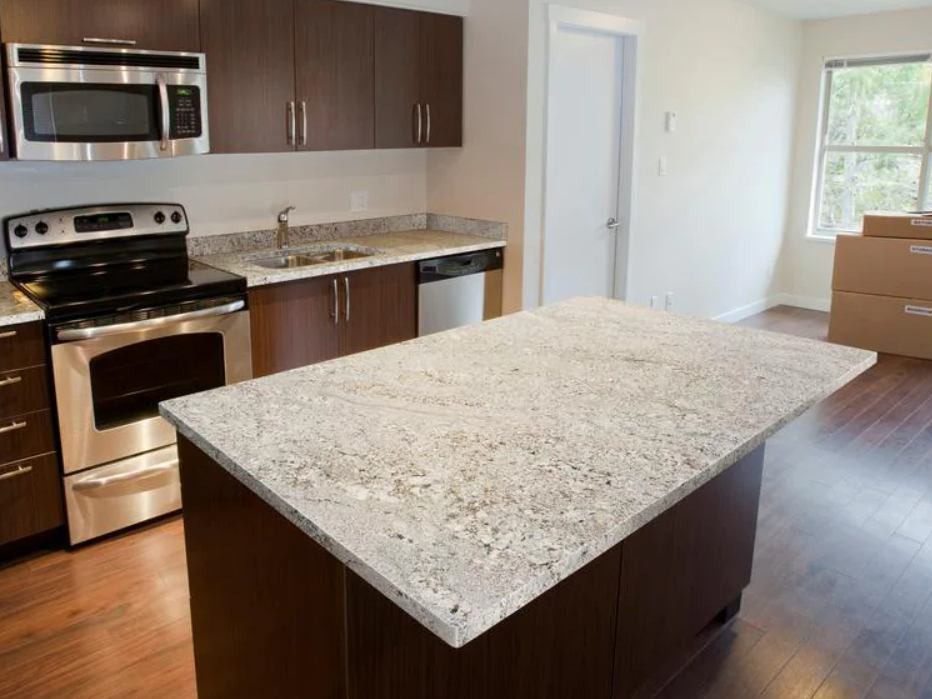
Like many granites used for countertops, Andino White originates in Brazil. It can be polished, honed (less reflective), or leathered (a soft sheen, textured option). While white granite suits many types of kitchen décor, it is particularly recommended where stainless steel is a prominent feature.
The mainly white or slightly off-white body can sometimes have large clear areas, but more often is speckled or rippled. The latter gives the appearance of the darker particles flowing across the surface, like a stream bed.
Color accents are usually beige, brown, and charcoal, with occasional black patches. It is generally a relatively affordable choice, though particular figuring (a trade term referring to the patterns in granite) can attract a premium. When properly finished, Andino White can be used inside or outside.
Key Characteristics: Andino White is a popular white granite suitable for a range of styles. Inclusions are beige, brown, charcoal, or black. It can be heavily speckled or rippled.
2. Moon White
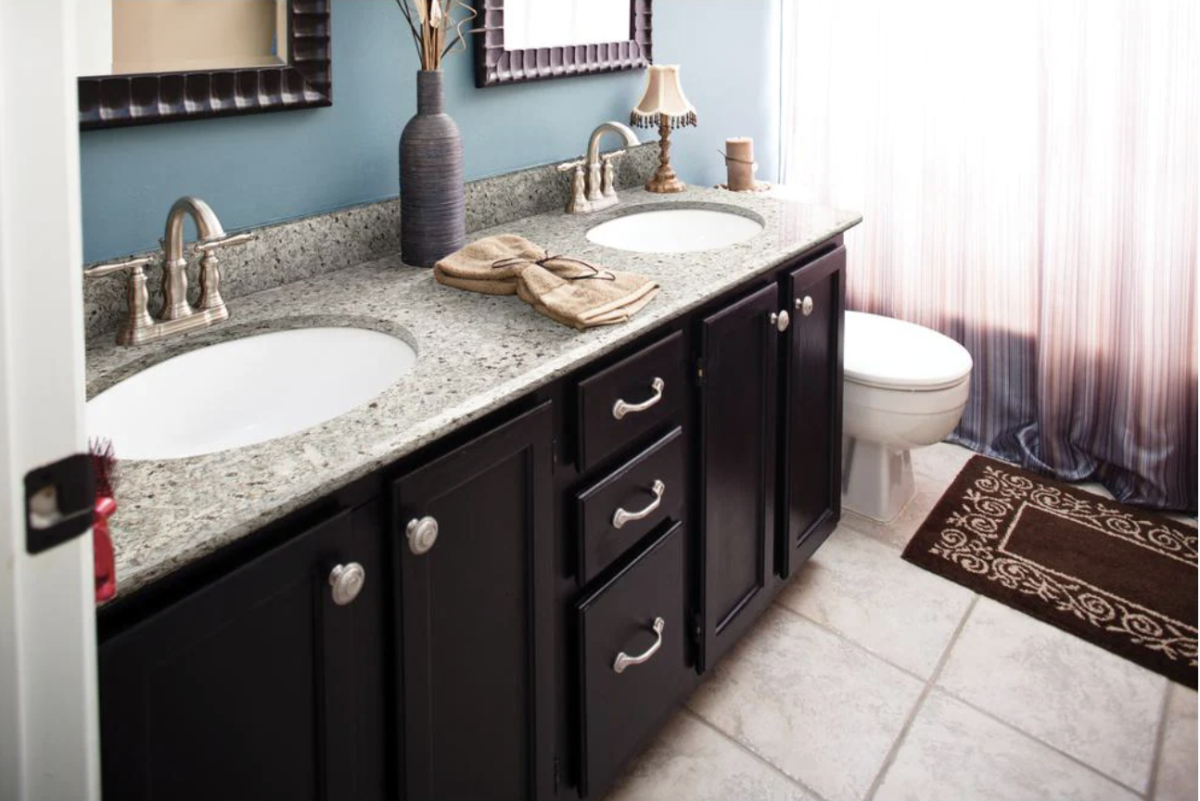
Moon White granite comes from India, and as the name suggests, it is one of the lightest of the white granite colors. Like all whites, it matches well with many décors, though it’s perhaps best in an uncluttered contemporary setting.
Moon White is notable for flecks that are smaller than most. Ivory and silver gray are occasionally interspersed with strong blacks. The inclusions can often appear to swirl gently across the surface, though in general it is a more subtle effect than other granite countertops colors.
Moon White is another of the more affordable choices for granite countertops. It’s very versatile and has the ability to withstand sub-zero temperatures.
Key Characteristics: A versatile granite with subtle figuring popular in contemporary settings. Inclusions in Moon White are ivory, silver gray, and black.
3. White Ice
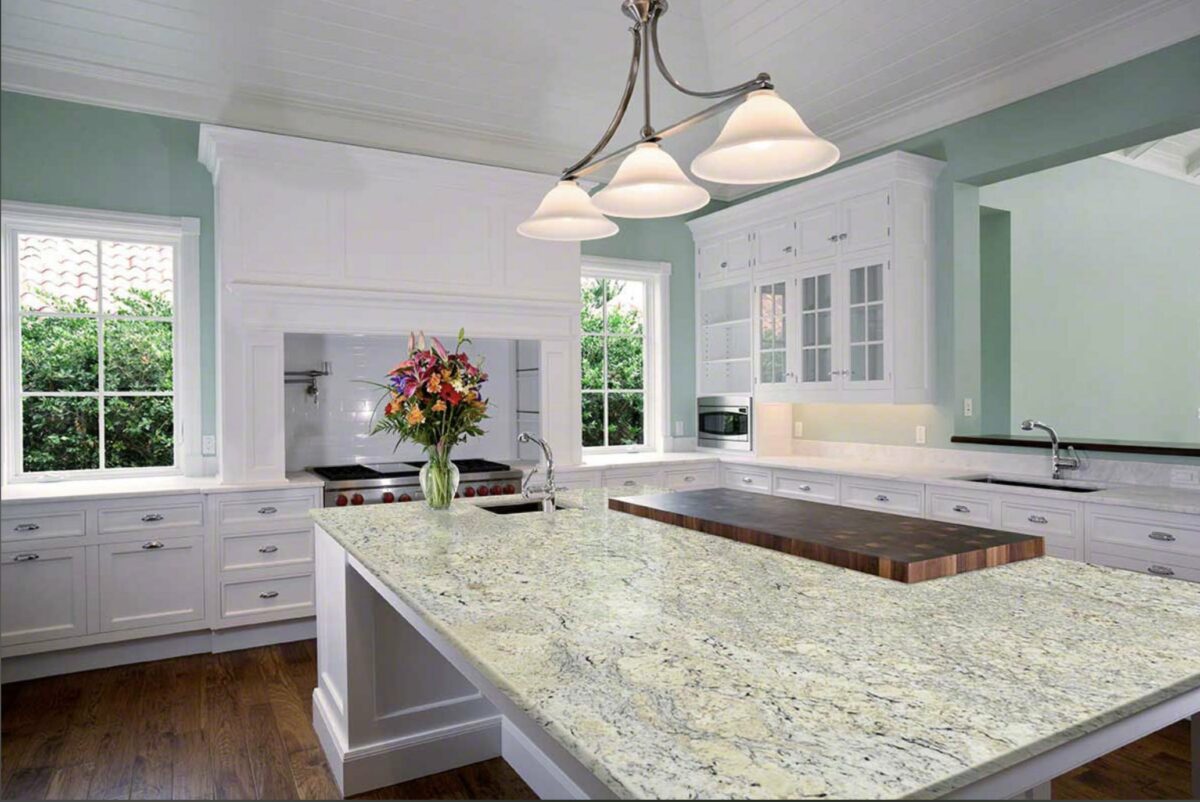
White Ice is another popular countertop granite from Brazil. With its strong veining, it can have quite a dramatic impact, though the colors lend themselves to modern interiors with cool grays or subtle pastels. It can be a striking contrast to dark colors, too.
Although white is the predominant color, grays, blues, blacks, and occasional browns run through the surface. These create a veined, patchwork effect reminiscent of the frozen landscapes from which it takes its name. Quartz flakes can also increase reflections, adding sparkle to the surface.
White Ice is less common than many other light-colored granites, and with its bold appearance, it often commands premium prices.
Key Characteristics: White Ice is a white granite that creates high visual impact. Inclusions are gray, blue, black, and brown.
Black Granite
Black granite has long been recognized for its ability to add a touch of luxury and drama. Few kitchen countertops can rival it for visual impact, with varieties that run from dense, almost solid-colored slabs to those that look like a star-filled night sky captured in stone.
The term “black granite” can be used for a variety of natural stone countertops, but frequently they are not granite at all. Technically, granite should contain a minimum of 20 percent quartz. Gabbro, a rock that is similar to basalt, is often sold as black granite. While strictly speaking this is incorrect, gabbro has the same toughness and durability as “true” granite and is equally suitable for kitchen countertops.
RELATED: The Best Countertop Material for Every Type of Kitchen
1. Absolute Black
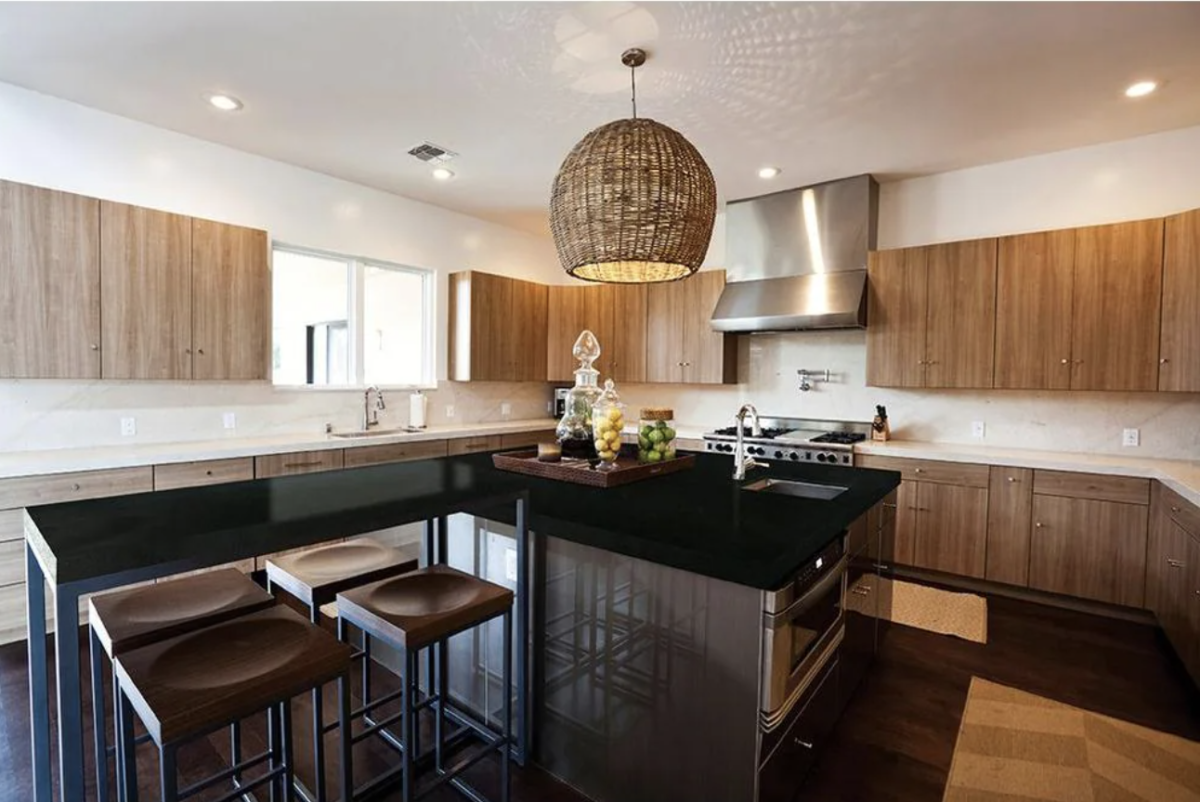
Absolute Black granite is another type that is quarried in India. With its high color consistency, it is the ideal choice for those looking for a sophisticated deep black with a low level of inclusions.
Also known as Jet Black or Nero Absolute, Absolute Black granite does have some figuring. Dense gray speckles can be seen when observed close up, though these usually disappear at a distance unless particularly strong lighting is used.
Black granites tend to be some of the more expensive options, and Absolute Black can command a premium price. It can be finished to a high polish, honed, or leathered. When sealed, it is equally suitable for outdoor cooking areas.
Key Characteristics: Absolute Black is visually the densest and most consistent of the black granites. Gray inclusions are often nearly invisible from a couple of feet away.
2. Black Galaxy
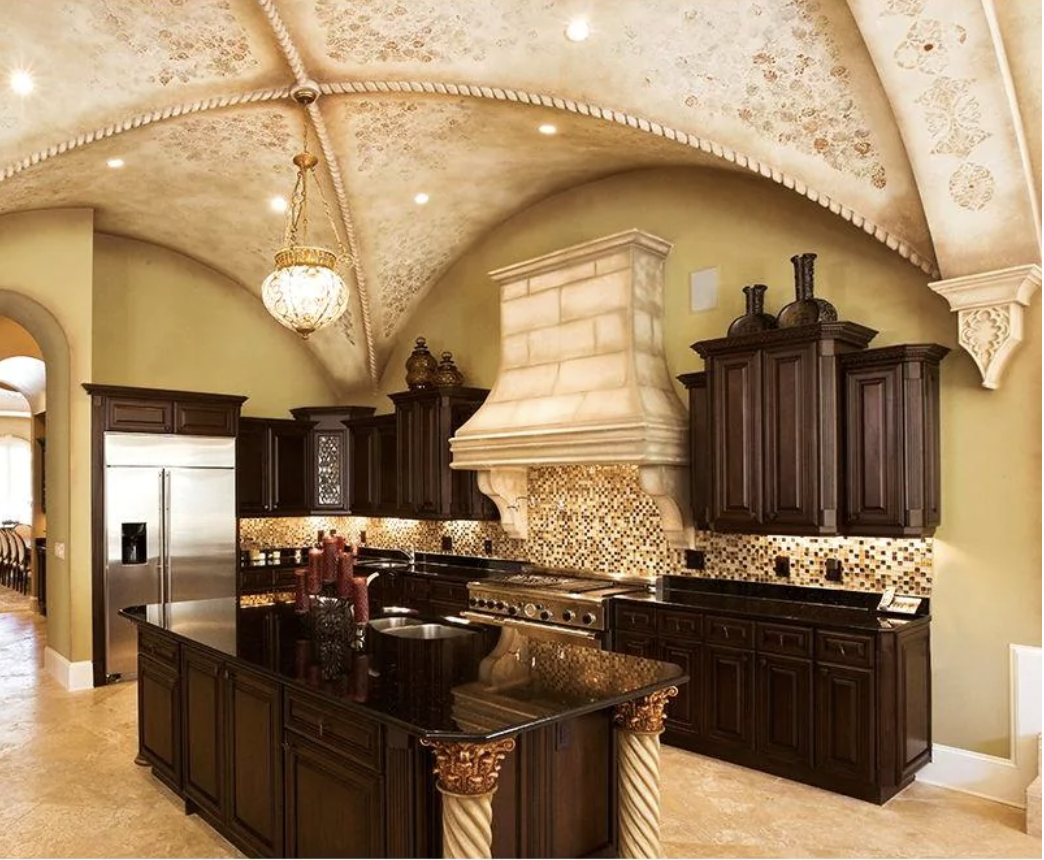
As the name suggests, Black Galaxy granite from India appears to capture a brilliant star-filled sky on a clear night. It is another granite that gives a truly luxurious look, and it’s often combined with dark woods for maximum impact.
Black Galaxy seldom has veining. While flecks are not dense, they are consistent across the surface. Colors are white, copper, silver, or gold. When the granite is polished, the flecks provide highly reflective counterpoints to the otherwise deep-black background.
Much like Absolute Black, Black Galaxy granite is often among the more costly types of countertops. Honed or leathered finishes are available, though these would mute the highlights for which Black Galaxy is popular.
Key Characteristics: With its reflective highlights, Black Galaxy granite can provide a truly spectacular countertop. Inclusions are white, copper, silver, or gold.
3. Ubatuba
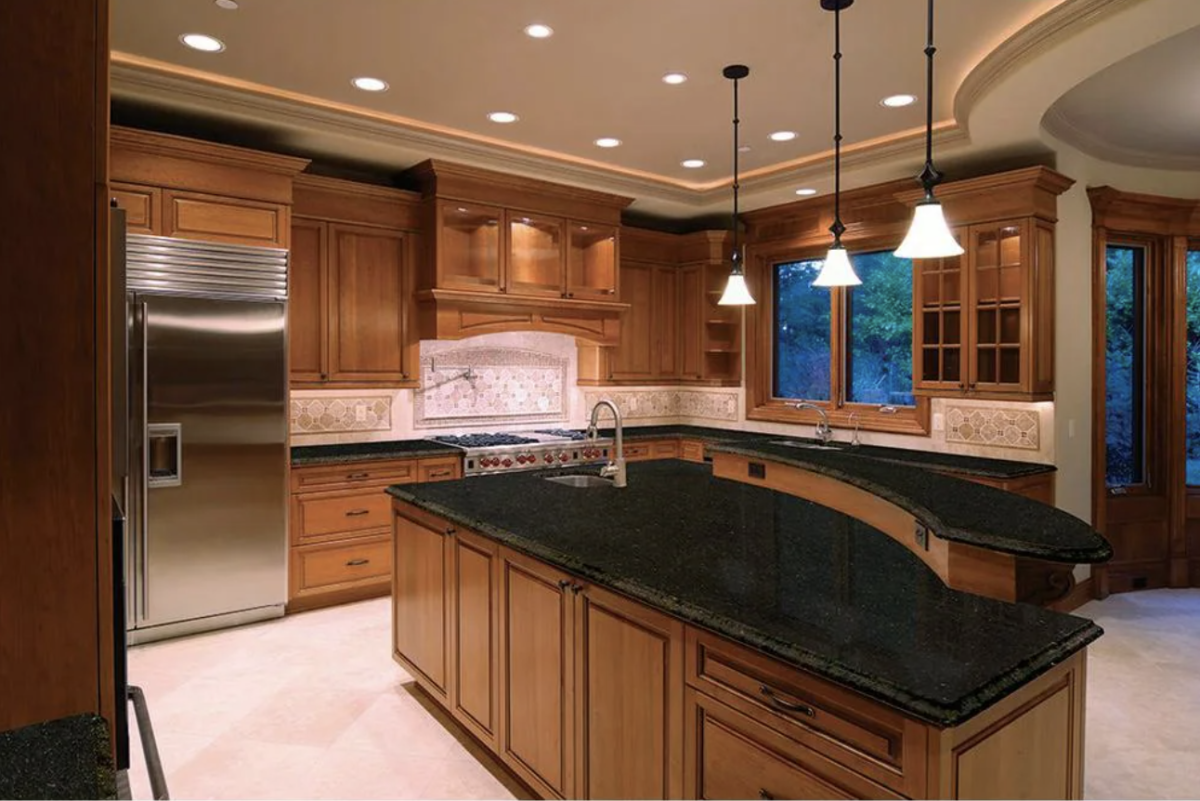
Ubatuba (also referred to as Uba Tuba) is another Brazilian granite. With its mica inclusions and multiple colors, it provides a truly luxurious look for kitchen countertops. While leathered and honed finishes are available, it is as a polished slab that it delivers its full appeal.
Ubatuba granite is flecked with a dazzling array of colors. There can be greens, browns, grays, and blacks, but gold is often the outstanding feature. The small size and dense distribution of these inclusions gives an overall sparkle to the surface, which is especially reflective when shown off by down lighting.
Despite its high visual impact, Ubatuba granite is widely available and usually carries a competitive midrange price.
Key Characteristics: A popular choice for classic luxury kitchen styles, Ubatuba sparkles when polished. Inclusions are green, brown, gray, black, and gold.
Gray Granite
The term “gray granite” might suggest a somewhat dull selection, but nothing could be further from the truth. Within the category of gray granite countertops there is arguably more diversity of color and figuring than with any other type.
It is true that many are subtle, and their neutral character makes them easy to match with many different decorative styles. That said, they can also be bright and dramatic. Within gray granites there are soft, smoky patterns, others tinged with green that appear almost like moss, and still others with strong veining.
Within gray granites there are blues, pinks, blacks, greens, silvers, and golds. They can be anything from mellow and warm to bright and reflective. “Gray” is a much-too-simple word for them.
RELATED: 10 DIY Countertops That You (and Your Wallet) Will Love
1. Bianco Antico

“Bianco” is actually Italian for “white,” but this Brazilian-sourced granite has a definite soft-gray background. Overall appearance can vary from light to medium depending on density. It is frequently chosen to pair with traditional white kitchen cabinets.
On closer inspection, Bianco Antico can have striking veining running through it, which almost seems to crackle. Visual texture can change considerably across a slab, so samples are not always representative; it is important to see the whole piece. Soft-brown inclusions sometimes give an overall pinkish hue. It may also have quartz crystals embedded in the surface, giving reflective highlights.
Bianco Antico is a mid-priced granite. It can be polished, honed, or leathered, each of which has its particular appeal, broadening its versatility still further.
Key Characteristics: A very popular granite for countertops, Bianco Antico goes particularly well with traditional bright and airy kitchens. Inclusions are gray, with occasional browns.
2. Costa Esmeralda

Costa Esmeralda is unique in that it is quarried in three different locations: Iran, Italy, and Brazil. Several suppliers claim the Iranian version is the “true” Costa Esmeralda. We have also seen the Italian product described as “Iran Green Granite.”
While classified as a gray granite, Costa Esmeralda has a pronounced green tinge. It may also have pale gray, green, or gold veins. Like Bianco Antico there can be considerable variation in patterning, so samples are rarely representative. Being natural stone, every piece of granite is unique, but the difference is more pronounced with Costa Esmeralda than with many others.
Despite its unusual coloring, Costa Esmeralda is not especially expensive, usually falling into the upper midrange price bracket.
Key Characteristics: Typically used with light-colored kitchens, Costa Esmeralda can also be successfully paired with woods like cherry. The overall greenish hue can be veined with light gray, gold, or darker green.
3. New Caledonia
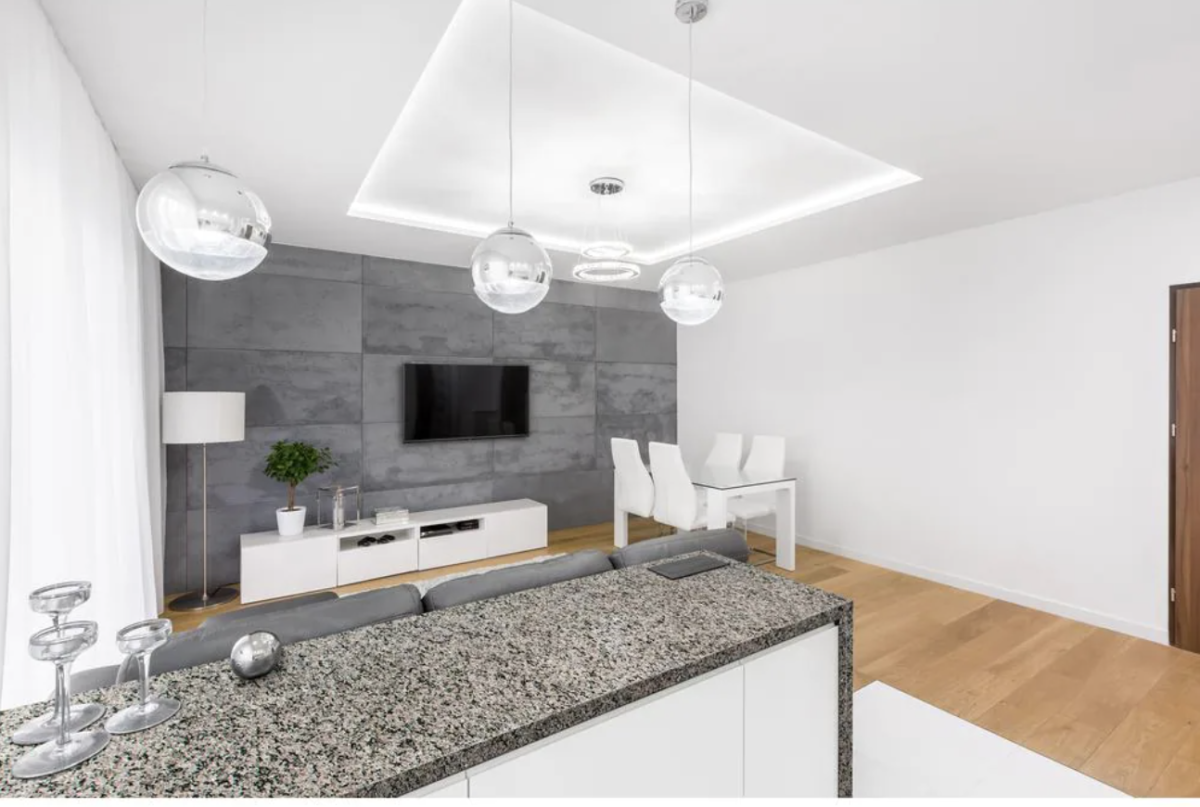
New Caledonia granite, quarried in Brazil, has a mottled appearance that is quite subtle at a distance but can have greater interest close up, depending on its color. While patterning is random, it is fairly dense and a consistent size across the surface. It pairs well with light wood or pale painted cabinetry.
While New Caledonia granite is quite often a collection of different grays and black, it can also incorporate many other colors; russets and browns are common. Sometimes the dispersal makes these appear lighter. It’s not unusual to find pinkish tones which can color whole granite slabs.
The versatility of New Caledonia granite makes it a very popular choice, yet perhaps surprisingly it comes with a budget price tag. This makes it one of the best value granites for kitchen countertops.
Key Characteristics: New Caledonia granite has random speckling, yet the density makes it appear quite uniform. Inclusions are usually various grays, though browns and reds may also appear.
Brown Granite
Brown granite is usually most popular with those who want to create a natural look in their kitchen. It has a warmth and a depth of color that still suggests quality, but is more subtle than most other granite countertop options.
Brown granite goes particularly well with wooden cabinetry and other wood furniture. Thanks to flecks of lighter brown, gray, or gold it can work equally well with light or dark tones. Some brown granite is particularly subtle and a great match for country-style kitchens. Others have more noticeable, irregular detail that suits contemporary designs.
Brown granite countertops are seldom about making bold statements and are more about creating a comfortable and welcoming feel.
1. Giallo Ornamental
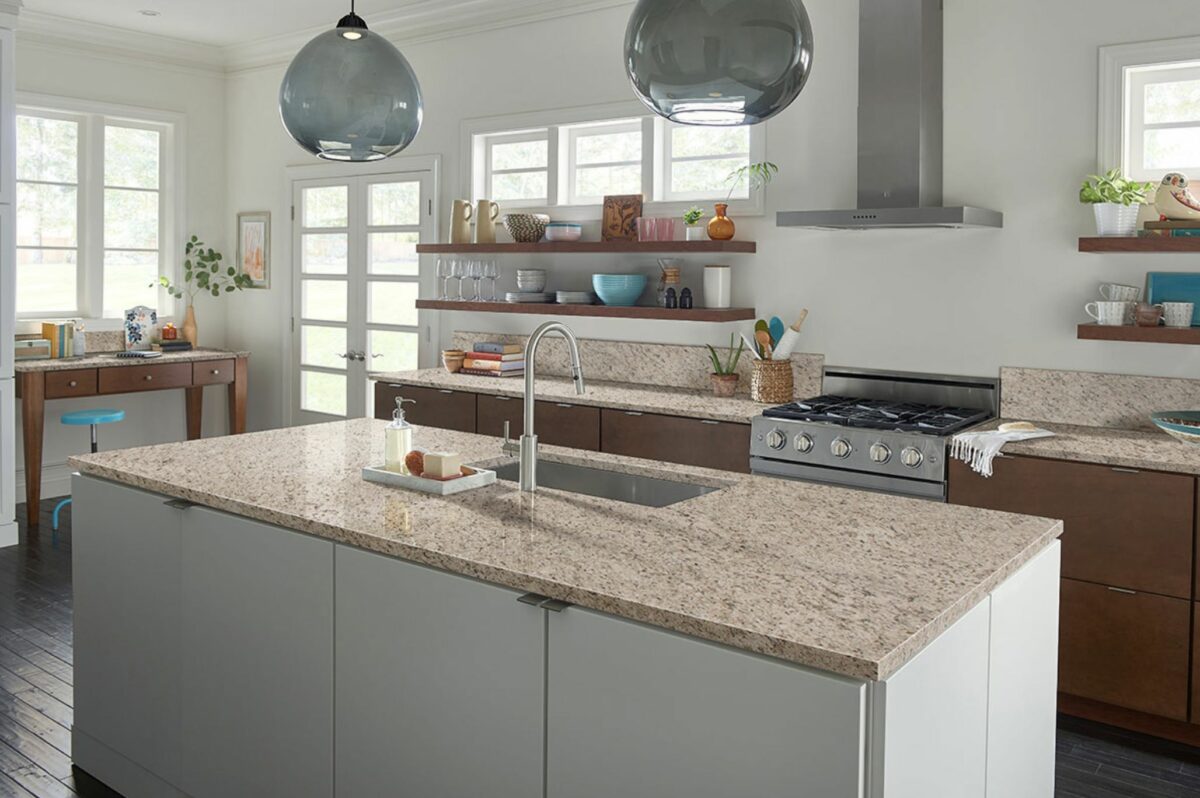
Some argue that Giallo Ornamental is actually a white granite, but with cream and tan tones over a large amount of the surface, the appearance is more that of a brown granite. Quarried in Brazil, it is also known as Amarello Ornamental and Giallo Santo.
Patterning can show some variation, but it is usually quite consistent with small to medium flecks that may include gold, darker brown, and black. It offers a natural warmth and is versatile, as it goes equally well with dark or light wood. Visually the darker hues in the granite become more prominent when fitted alongside the latter.
A popular choice in traditional and rustic kitchens, Giallo Ornamental is another brown granite that comes with a very modest price tag.
Key Characteristics: Giallo Ornamental is at its best when paired with natural woods, and it works with almost all tones. Inclusions are predominantly cream, tan, and gray, though darker browns, gold, and black also appear.
2. St. Cecilia
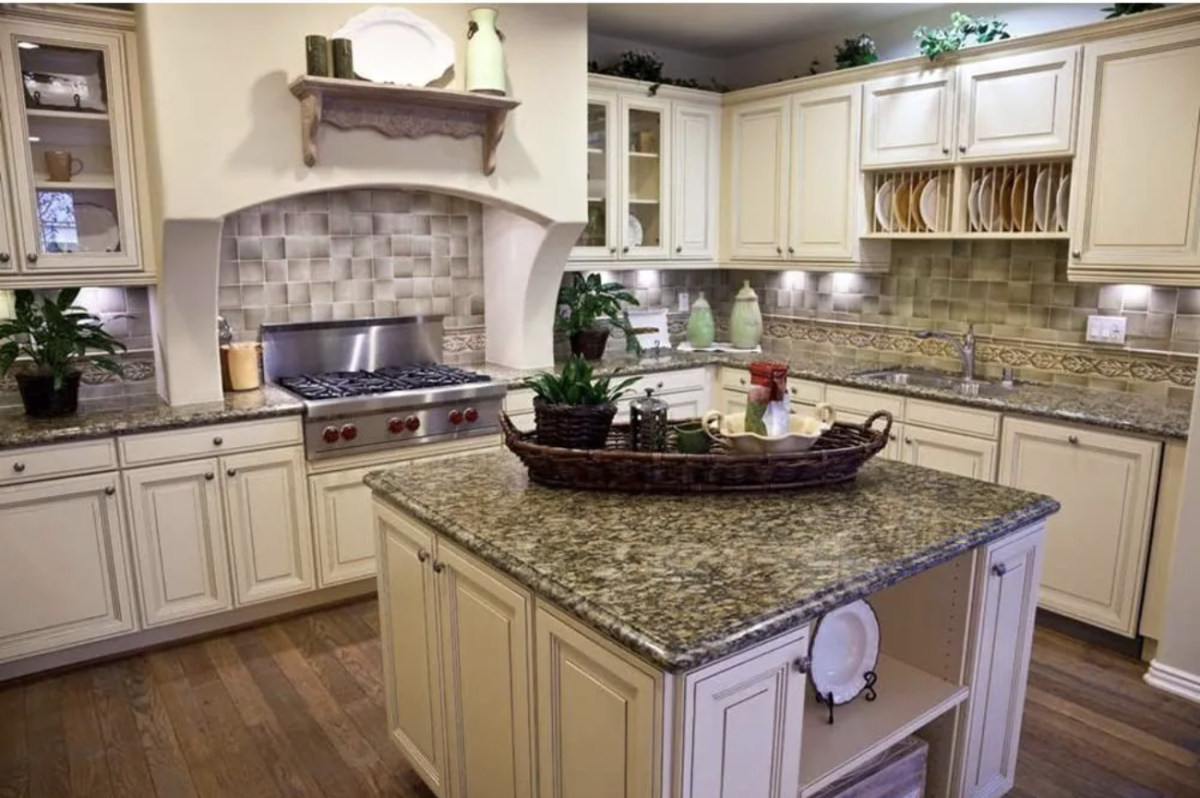
St. Cecilia, or Santa Cecilia, is a very popular brown granite quarried in Brazil. Its visual appeal and versatility make it a consistent favorite in kitchen and bathroom showrooms.
The main body is cream and tan, but with around 25 percent black included it has vibrancy to go with the natural warmth. Flecks vary in size and are accompanied by short veined sections that give a feeling of movement across the surface. There are also patches of quartz which can reflect room lighting if a polished finish is chosen.
In keeping with the typically low cost of brown granites, the price of St. Cecilia is as attractive as the visual appeal.
Key Characteristics: St. Cecilia is a more vibrant brown granite, but one that retains a natural feel. Inclusions are cream, tan, and black.
3. Venetian Gold
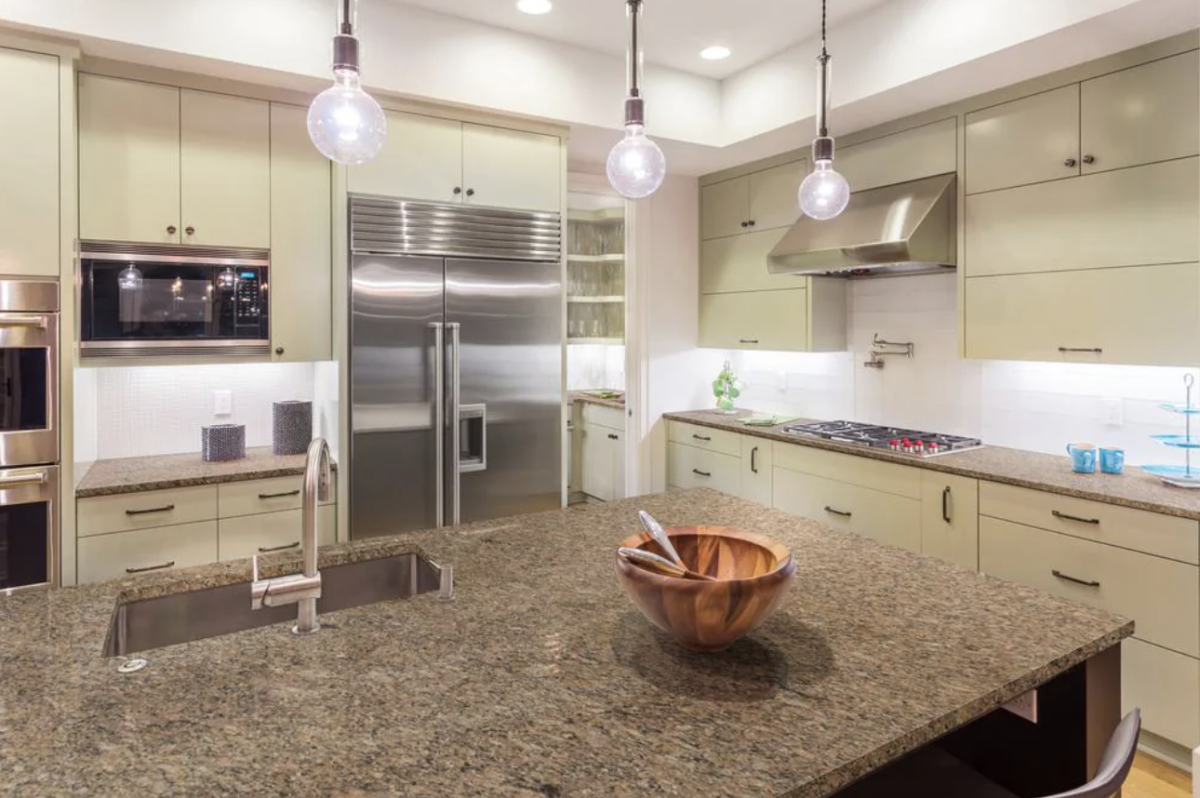
Venetian Gold, also sold as New Venetian Gold, is quarried in Brazil. It has medium to large flecks that look somewhat like bark, and occasional light or dark veining. Usually polished, it is a great match for woods like oak, maple, and cherry.
Beige and honey colors are dominant with Venetian Gold granite, though amber, reds, grays, and blacks can also be found. While usually the patterning is fairly consistent, veining is sometimes present, running across the surface in long strands. As with many granites, using samples to get a representative color can be challenging as they often differ from a full slab.
Brown granites often represent excellent value, and Venetian Gold is usually very competitively priced.
Key Characteristics: Venetian Gold offers warm, natural, earthy tones that work well with wooden kitchen furniture. Inclusions can be cream, honey, amber, red, gray, and black.
